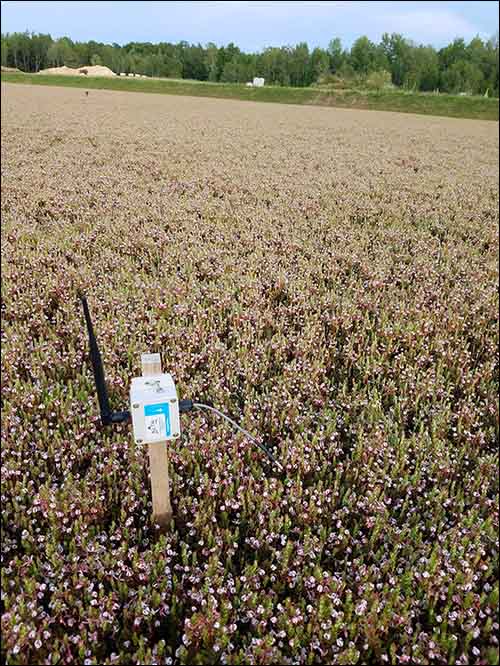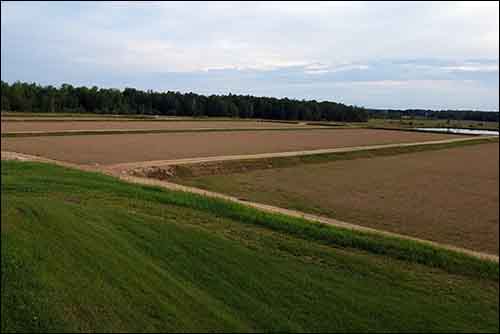Hilltop Cranberry Co. is using an Internet of Things-based sensor system to track the conditions around its temperature-sensitive crops. The solution, provided by Monnit Corp., consists of temperature and humidity sensors that transmit measurements wirelessly to a receiver. The Monnit cloud-based solution can then issue alerts to the company at any time of the day or night when conditions are such that the plants and their berries are at risk. The system, installed this spring, not only prevents the potential loss of an entire crop if the temperature dips too low, but also provides owner Travis Tritz with a better night’s sleep, since he doesn’t need to spend cool nights watching the temperatures.
Hilltop Cranberry has a 19-acre marsh in Vesper, Wis., that includes five cranberry beds that are, at times, submersed in water. The berries are especially vulnerable to freezing at the time that the buds are opening. Frost, at that time, can result in no berry growth the following season. If temperatures dip below freezing during the budding point in the plant’s growth, cranberry growers typically turn on sprinklers to spray the plants and thereby prevent frost damage.

For cranberry farmers, this can often lead to sleepless nights as they watch weather conditions. Tritz has addressed the problem via a temperature alarming system at his home that wakes him up if the temperature drops below a specific temperature, indicating that he needs to check the plants and possibly turn on the irrigation system.
The temperature at his home can be as much as 16 degrees above the temperature at the fields, Tritz notes, so this is not a foolproof solution. The temperature at his home has been as much as 16 degrees above that of the cranberry fields. Therefore, when the temperature has reache 45 to 48 degrees at his home, he has often been forced to go out and spend the night watching the temperatures on the manual thermometers. To create a more precise solution, he began seeking a wireless solution and opted for Monnit’s Remote Monitoring System, based on the solution’s price and the flexibility of the company’s representatives.
Monnit’s system consists of IoT-based sensors for the agriculture market that can track temperature, humidity, light and carbon dioxide levels around plants, says Brad Walters, Monnit’s CEO and founder. The sensors capture measurements and transmit the data to the receiver via a 900 MHz signal. The receiver acts as a gateway and forwards that information to Monnit’s software via a cellular connection. The software interprets the data and can prompt a hierarchy of messages until someone responds to them.
The sensors, contained in a waterproof casing, are attached to stakes, with at least one installed in each of Hilltop’s beds (which measure about 170 feet in width and 700 to 1,200 feet in length). Each sensor is mounted above water, even when the bogs are filled, while a probe extends into the water or soil.
In the case of the Hilltop Cranberry solution, Tritz receives e-mail and voice messages alerting him to a temperature problem, and if he fails to respond, the system sends a voice phone call. His wife receives a follow-up message if he still does not respond by selecting a prompt in the software to indicate he has seen the message.

Hilltop Cranberry is using the temperature and humidity sensors only. However, Tritz says, Monnit also offers vibration sensors for irrigation equipment and generators, which enable users to identify whether their equipment has been turned on, as well as whether or not it is running properly. If a user so chooses, the sensors can also receive messages from a remote user to turn the equipment on; however, Hilltop is not yet using this function. The Monnit software can also display data on a map and provide historical analytics to better understand trends.
Since he began using the technology several months ago, Tritz reports, the system has been working well. “We haven’t had any issues with it,” he states. The first night on which there was a frost, he sat up watching the measurements as they came in, and was able to confirm that it alerted him when necessary.
The technology’s value, Tritz explains, comes from ensuring that an entire crop is neither damaged nor destroyed by frost. Since the IoT system’s deployment, he says, he has been able to monitor the actual temperature in the fields without having to go out and physically check his manual thermometers. He can now sleep knowing that the system will alarm him if the temperature reaches his preset critical temperature level.
However, he says, he has seen interesting results from the temperature data that provide other benefits as well. For instance, he can view temperature patterns that indicate the direction in which cold air tends to blow over the beds, as well as which beds are more vulnerable and when this becomes a problem. This data could make it easier for the company to predict temperature changes and the need to prevent problems during certain weather conditions.

